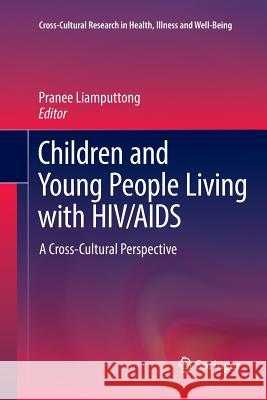Children and Young People Living with Hiv/AIDS: A Cross-Cultural Perspective » książka



Children and Young People Living with Hiv/AIDS: A Cross-Cultural Perspective
ISBN-13: 9783319806907 / Angielski / Miękka / 2018 / 497 str.
Children and Young People Living with Hiv/AIDS: A Cross-Cultural Perspective
ISBN-13: 9783319806907 / Angielski / Miękka / 2018 / 497 str.
(netto: 384,26 VAT: 5%)
Najniższa cena z 30 dni: 385,52
ok. 22 dni roboczych
Bez gwarancji dostawy przed świętami
Darmowa dostawa!
This book focuses on the issues encountered by children and young people who are living with HIV/AIDS.
"The 51 contributors share rural and urban experiences studying children and adolescents living with HIV/AIDS. ... The editor and most authors provide literature reviews and extensive references, and compare population statistics, prevalence rates, morbidity/mortality data, teen pregnancy rates, and more. ... Summing Up: Recommended." (E. R. Paterson, Choice, Vol. 54 (5), January, 2017)
Chapter 1. Children, young people and HIV/AIDS: An Introduction; Pranee Liamputtong.- Part I. Children, Young People and Living with HIV/AIDS.- Chapter 2. Unpacking ‘OVC’: Locally Perceived Differences between Orphaned, HIV-Positive and AIDS-Affected Children in Zimbabwe; Morten Skovdal, Catherine Campbell, Zivai Mupambireyi, Laura Robertson, Constance Nyamukapa and Simon Gregson.- Chapter 3. Children’s Experiences of Living with HIV-Positive Parents within the Family Context of Bangladesh; Md Shahidul Islam, John Scott and Victor Minichiello.- Chapter 4. Adolescents Living with HIV: Emerging Issues in Public Health in South Africa; Nataly Woollett.- Chapter 5. Living Optimally with HIV: Youth Experiences in a Metropolitan Canadian City; Michelle DiRisio, Peri J. Ballantyne and Stanley Read.- Chapter 6. “There’s More to You than Just this Virus”: Young People Growing Up with Perinatally-Acquired HIV in Australia; Asha Persson, Christy E Newman and Angela Miller.- Part II. Children, Young People, HIV/AIDS, Identity and Risk.- Chapter 7. Masculinities, Femininities and the Burden of Culture Among Rural South African Teenagers in the Context of HIV; Deevia Bhana.- Chapter 8. “Digging Your Own Grave”: Ghanaian Young People’s Construction of Vulnerability within The Context of HIV/AIDS; Georgina Yaa Oduro.- Chapter 9. HIV/AIDS Knowledge and Risk of HIV/AIDS among Street Children in South Africa; Sylia Niele and Pranee Liamputtong.- Chapter 10. “I Definitely Want Kids, But I Think The Risks Are Pretty High”: Fertility Desires and Perinatal HIV Transmission Knowledge among Adolescents and Young Adults with Perinatally-Acquired HIV (PHIV); Cynthia D. Fair and Jamie Albright.- Chapter 11. Men Who Have Sex with Men (MSM) in Accra, Ghana and Lomé, Togo: Sexual History and HIV Risk Behavior; Ami Moore and Adobea Yaa Owusu.- Chapter 12. Mental Health Problems and Associated Socio-Ecological Factors among HIV-Positive Young Migrant Men Who Have Sex with Men in China; Haochu (Howard) Li, Joseph Lau, Eleanor Holroyd and Xiaoming Li.- Chapter 13. Young LGBT People and HIV/AIDS Risks: A Metasynthesis; Pattaraporn Moolchaem and Pranee Liamputtong.- Part III. Children, Young People, Health Care, Interventions and Policies.- Chapter 14. HIV/AIDS and Children in Jamaica: National Policy and Institutional Responses; Paul Miller and Stephen Wallder.- Chapter 15. HIV Prevention for Adolescent Women in Africa: Structural Driver Interventions; Catherine MacPhail and Audrey Pettifor.- Chapter 16. In Search of Entrepreneurs, Children and HIV/AIDS in Cameroon: A Marginalized Issue?; Larissa Kojoué.- Chapter 17. Disclosure as a Positive Resource: The Lived Experiences of HIV-Positive Adolescents in Botswana; Vivian Midtbø and Marguerite Daniel.- Chapter 18. The Power of Online Patient Communities for HIV Youth; Gonzalo Bacigalupe, Kathryn Cantrell and Rachel Chickerella.- Chapter 19. The Power of Peers: Self-Stigma Impacts, Peer Support and Engagement; Magda Conway.- Chapter 20. Teens and Transitions: Supporting Young People with HIV to Move Successfully from Pediatric to Adult Healthcare; Corry Azzopardi, Robyn Salter, Stephanie Savage, Ari Bitnun, Jason Brophy and Stanley Read.- Chapter 21. “I Can Still Be Happy, I Can Still Get My Life Again”: Psychological Interventions With Children, Young People and Families Living With HIV in the UK; Tomás Campbell and Jayne Griffiths.- Chapter 22. Lay Definitions of Antiretroviral Treatment: Unpacking the Paradoxes and Dilemmas of Therapeutic Efficacy in Rural Tanzania; Mangi J Ezikiel.- Part IV: Children, Young People & Research.- Chapter 23. Ethical Considerations of Conducting Research among Children and Young People Affected by HIV: A View from An Ethics Review Board; Katie Schenk and Saumya Ramarao.- Chapter 24. Can Pictures Influence Policy? Ugandan Children Share Stories Utilizing Photovoice; Bonnie Fournier and Olenka Bilash.
Pranee Liamputtong is a medical anthropologist and holds a Personal Chair in Public Health at the School of Public Health, La Trobe University, Melbourne, Australia. Pranee has previously taught in the School of Sociology and Anthropology and worked as a public health research fellow at the Centre for the Study of Mothers’ and Children’s Health, La Trobe University. Pranee has a particular interest in issues related to cultural and social influences on childbearing, child-rearing, and women’s reproductive and sexual health. She has published several books and a large number of papers in these areas.
1997-2025 DolnySlask.com Agencja Internetowa
KrainaKsiazek.PL - Księgarnia Internetowa









